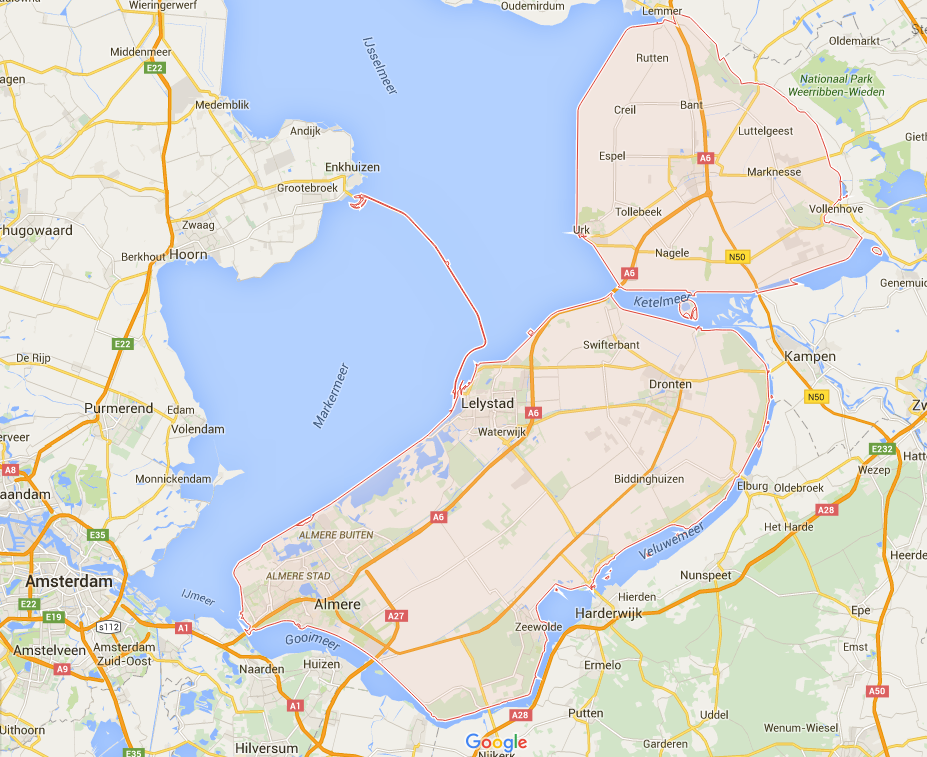The Dutch Province Flevoland – A Peculiar Story Posted by Sten on Oct 20, 2015 in Uncategorized
The province of Flevoland has not always existed. Not only in its name and demarcation – no, the actual land did not exist. It came into existence as the last of the twelve Dutch provincies. The northern Noordoostpolder (the top red part of the province in the map below) was added to the already existing land. The lower two parts of the province, Oostelijk and Zuidelijk Flevoland (Eastern and Southern Flevoland) are detached from the mainland. They are connected with five bridges to the rest of the country. This makes this part of Flevoland the largest artificial island in the world.
The land is used differently than it would be used normally. Agriculture is the primary land use. There are a few major cities in Flevoland too, though. Almere, Emmeloord and Lelystad, its capital.

What the Flevoland’s landscape looks like – a lot of windmills, and a lot of flat, agricultural lands (Image by Floris Oosterveld at Flickr.com)
Why?
Now, it must have been a huge job to drain so much land. Why all the hassle? Already 400 years ago, the Zuiderzee, as the former IJsselmeer was called, caused many overstromingen (floods). The idea was to tame the sea through giving it less space. However, in the 1600s, the technologies to buy dykes had not progressed far enough.
In 1891, then Minister van Waterstaat Cornelis Lely published his proposal of the Zuiderzeewerken. This included the now famous Afsluitdijk, to convert the lower part of the Zuiderzee into the IJsselmeer – from sea into a lake. The upper part was named the Waddenzee, which is mainly the water between the Dutch islands and the mainland. This conversion would calm the Zuiderzee down much more, and would make it more controllable. However, security was not the primary aim anymore. The kleigronden (clay soils) were very useful for agriculture, but were under a layer of water of the Zuiderzee. So another part of the Zuiderzeewerken plan was the inpoldering (reclamation of land) of certain areas. Today, you can see very well that the province’s main purpose is agriculture.
How it was done
So how was Flevoland created? Dijken (dykes) are built to keep the water out, and with gemalen (pumping station – do not confuse gemaal here with its other meaning, husband!) the water was pumped out. As you can guess, Flevoland lies below the sea level – about 5 m (15 ft)!

A gemaal. You can see the pipes through which the water is pumped from the lower side to the higher side. The lower side becomes drier, and the dykes keep it from getting wet again. Many windmills also used this purpose. (Image by Johan Wieland at Flickr.com)
First, the Afsluitdijk was built, already in 1932, to calm down the Zuiderzee, and make it much easier for the inpoldering. For Flevoland, the Noordoostpolder was added first, in 1942. The drooglegging (drainage) continued with Oostelijk Flevoland in 1957, and ended with Zuidelijk Flevoland in 1968.
Interestingly, Urk, a city in the Noordoostpolder, formerly was an island! The same counts for Schokland, which was added to the mainland in 1942.
Flevoland is very close to Amsterdam too in the Zuidelijk Flevoland part. The city of Almere has already agglomerated to Amsterdam. And from the very natural province of Flevoland, you can have an excellent view over the skyline of the Dutch capital.

Build vocabulary, practice pronunciation, and more with Transparent Language Online. Available anytime, anywhere, on any device.
About the Author: Sten
Hi! I am Sten, both Dutch and German. For many years, I've written for the German and the Dutch blogs with a passion for everything related to language and culture. It's fascinating to reflect on my own culture, and in the process allow our readers to learn more about it! Besides blogging, I am a German-Dutch-English translator, animator and filmmaker.





